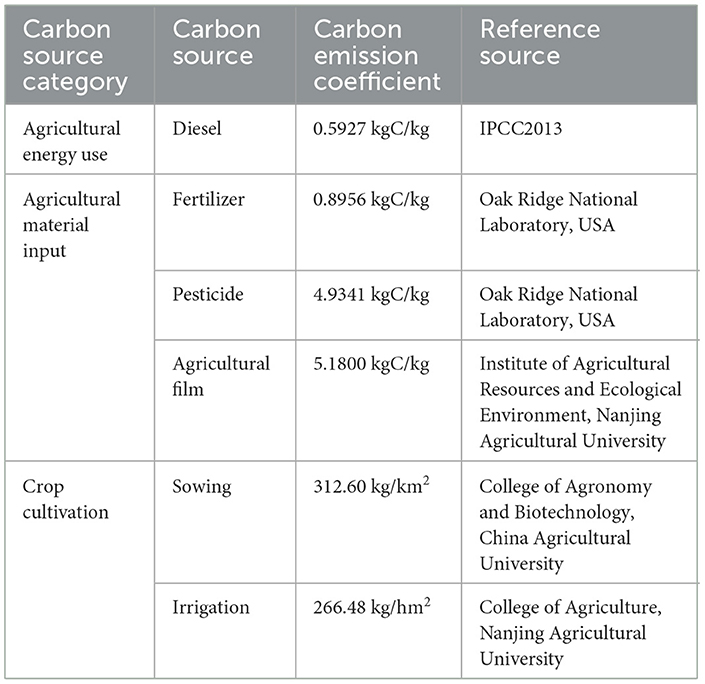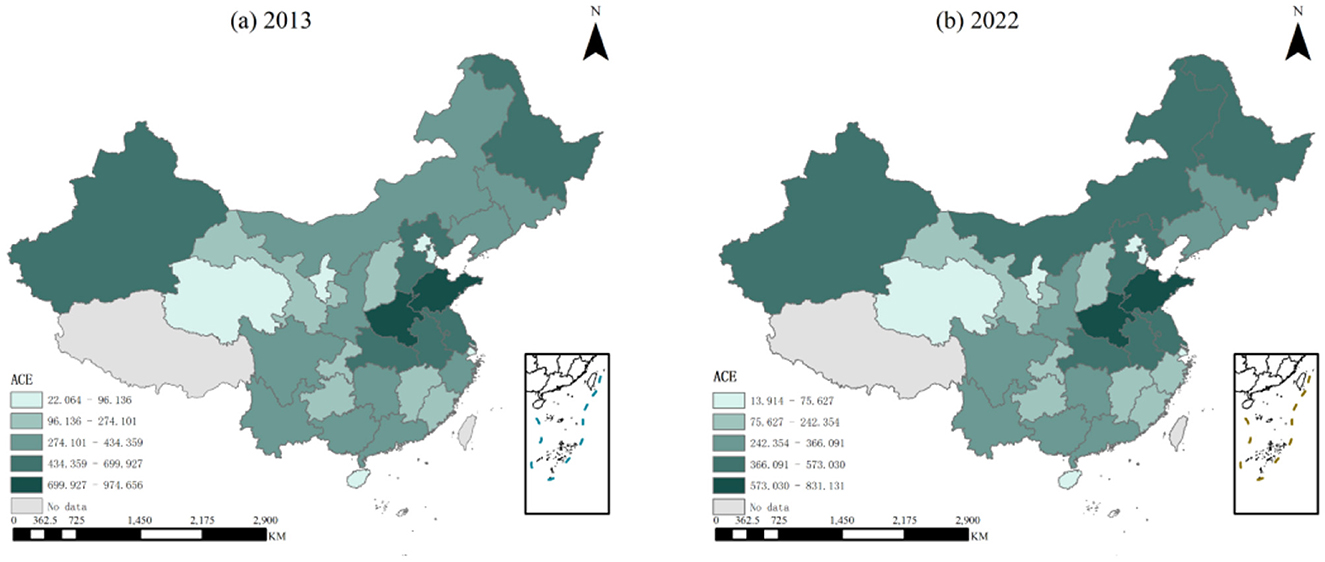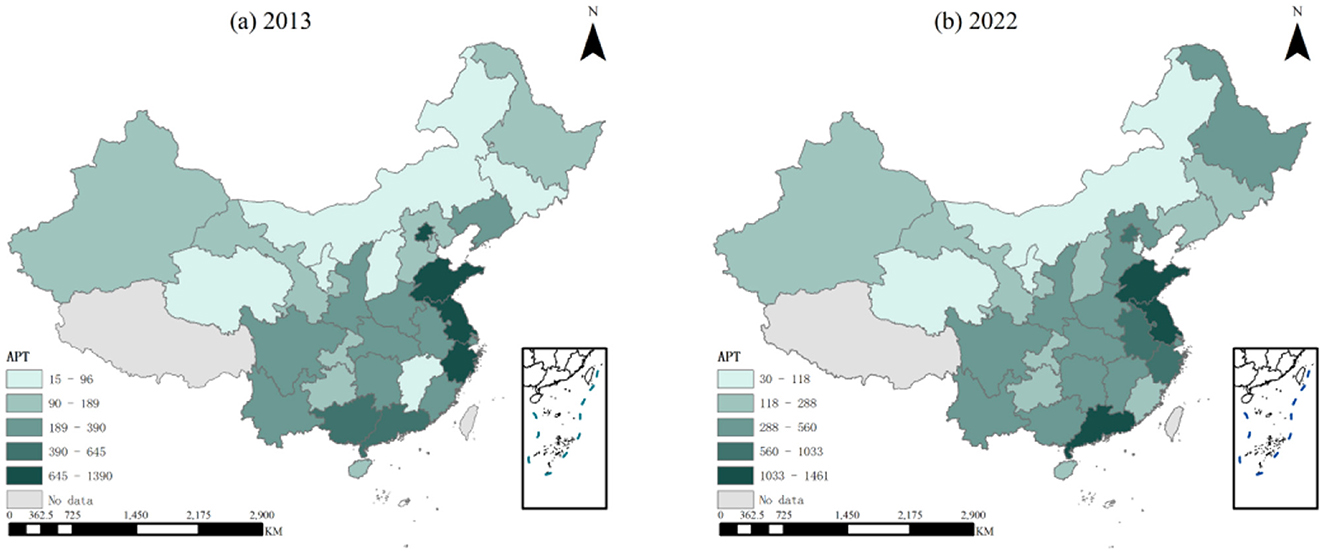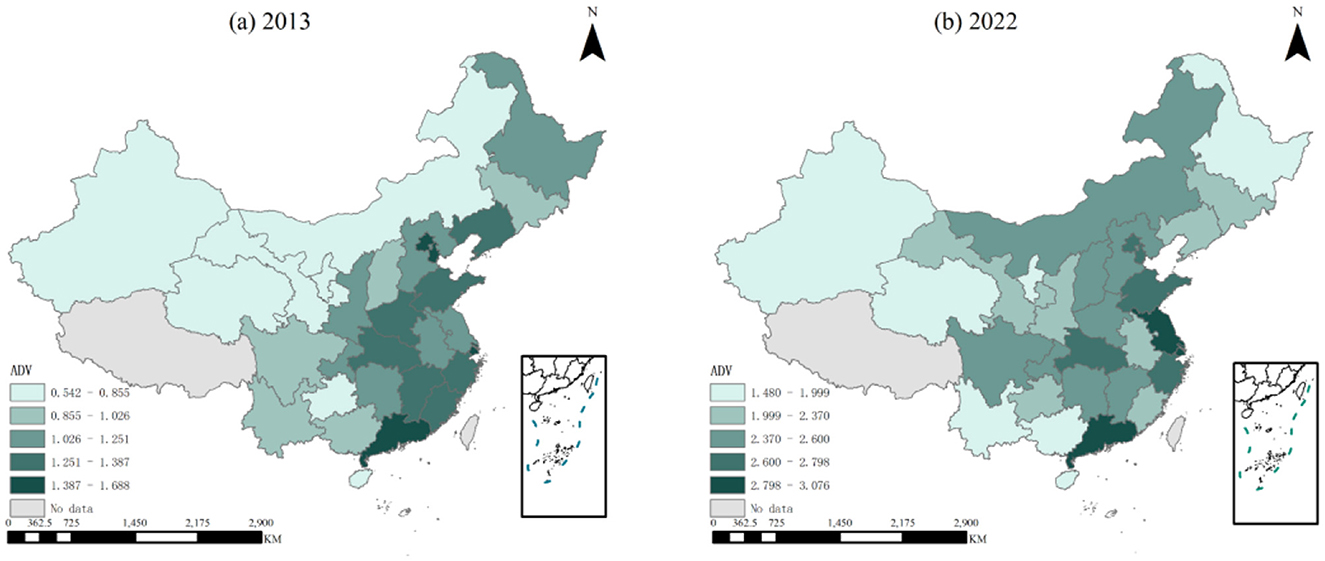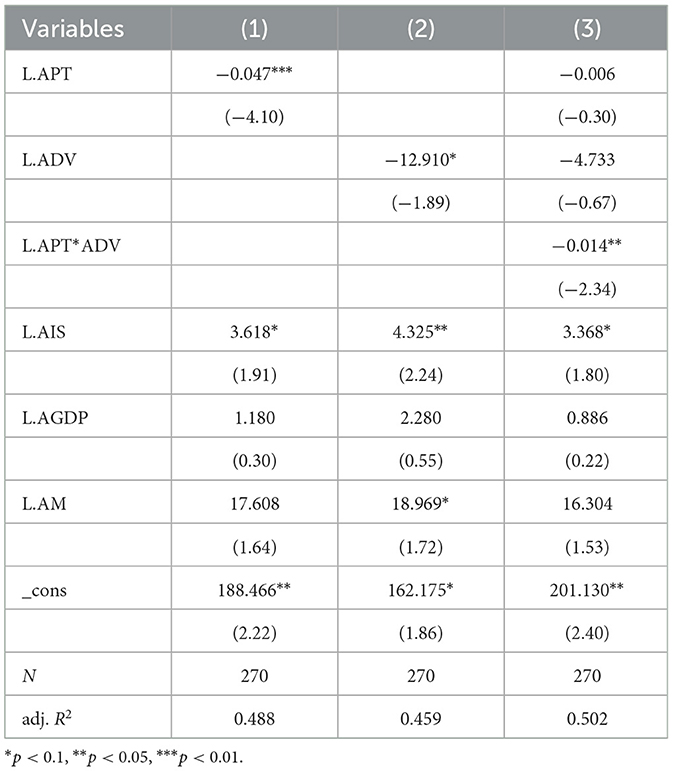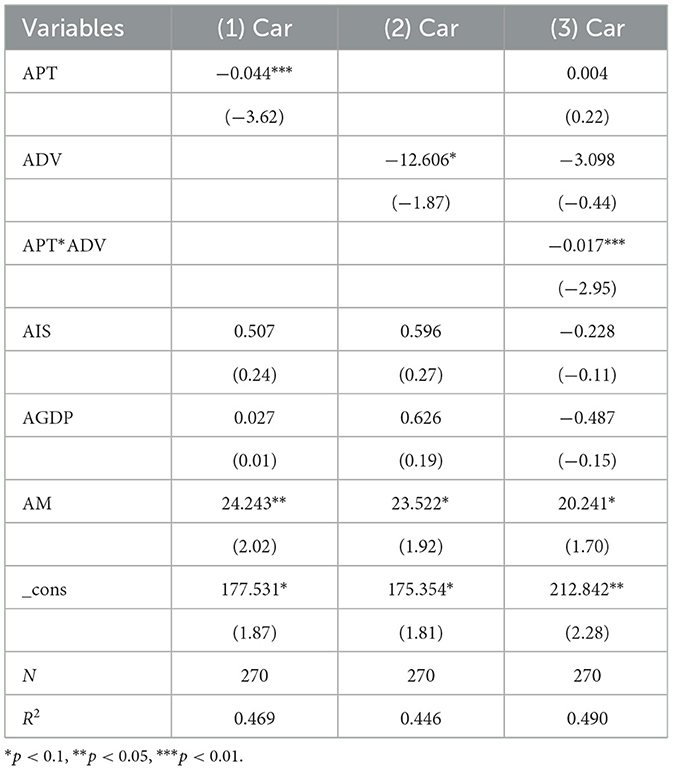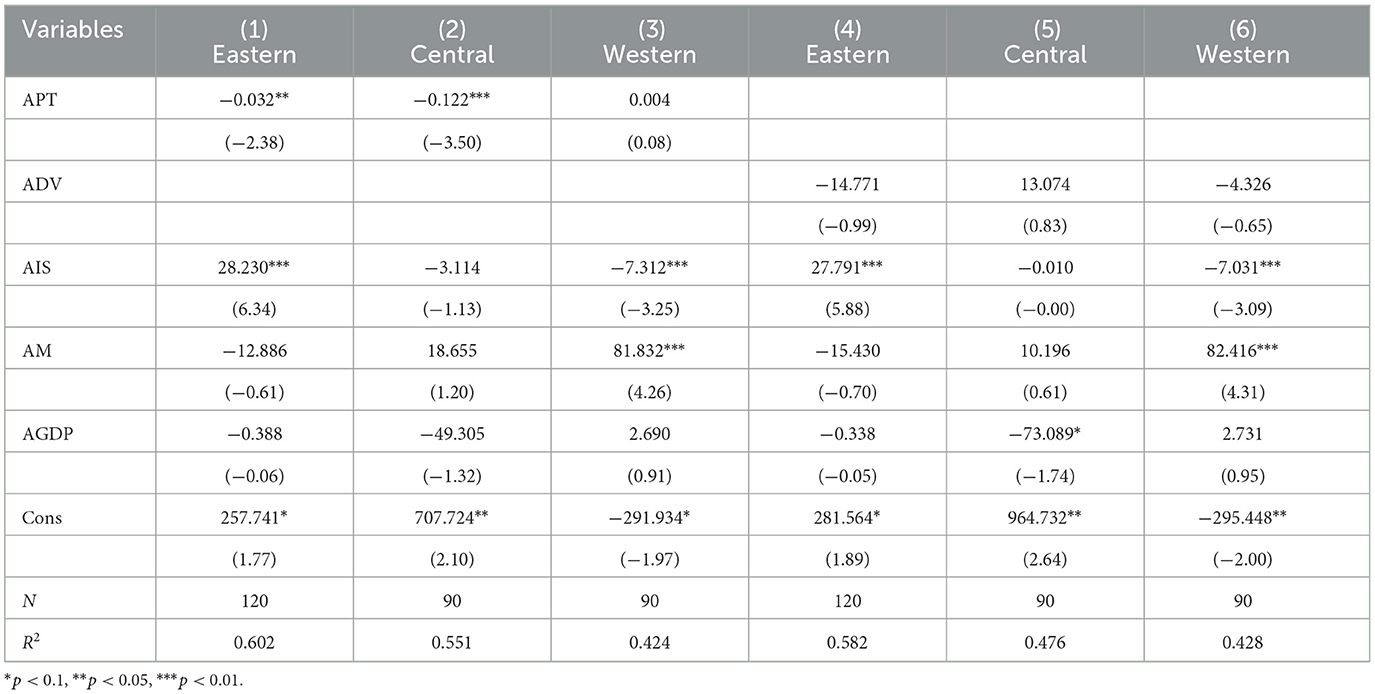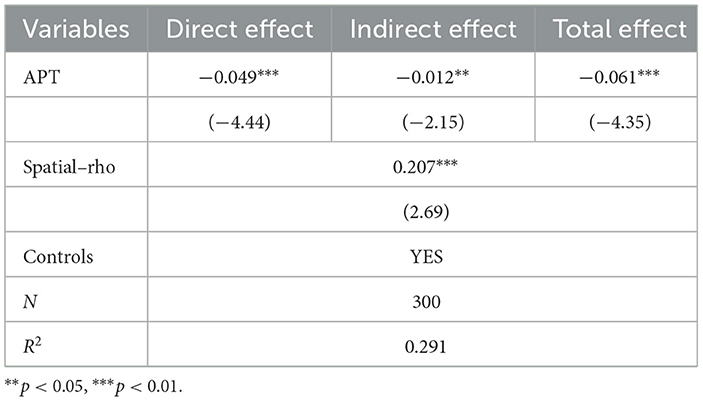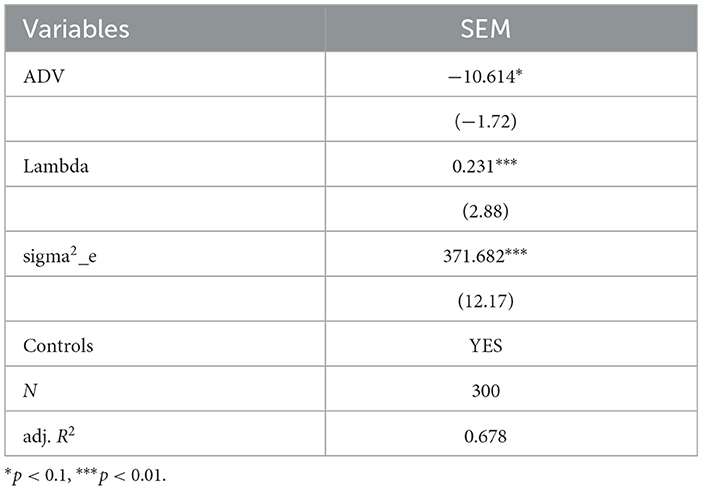- 1School of Geography, Geomatics and Planning, Jiangsu Normal University, Xuzhou, Jiangsu, China
- 2School of Geography, Jiangsu Second Normal University, Nanjing, Jiangsu, China
Under the context of global warming, the continuous rise in greenhouse gas emissions has become a critical concern. As a significant source of greenhouse gas emissions, the carbon emissions from agriculture exert a considerable impact on climate change, which cannot be overlooked. Agricultural technological innovation is crucial for reducing carbon emissions. Examining how the scale and structure of agricultural technological innovation impact agricultural carbon emissions is important for achieving the Carbon Peaking and Carbon Neutrality Goals. This research is based on data from 30 provinces in China over the period of 2013–2022. It utilizes fixed-effects models, moderation models, and spatial econometric models to empirically investigate the impact mechanisms of the scale and diversity of agricultural technological innovation on agricultural carbon emissions. The research findings reveal that: (1) China's agricultural carbon emissions exhibit an overall declining trend, while the scale of agricultural technological innovation and the level of technological diversity demonstrate a general upward trend. However, regional disparities exist. The total agricultural carbon emissions in the central regions remain relatively high, whereas the scale of agricultural technological innovation and the level of diversity decrease progressively from the southeastern coastal areas toward the inland regions. (2) The scale of agricultural technological innovation and the diversity of technologies have a significant inhibitory effect on agricultural carbon emissions. (3) Mechanism analysis reveals that the scale of agricultural technological innovation positively moderates the impact of technological diversity on agricultural carbon emissions. Specifically, an increase in the scale of technological innovation enhances the inhibitory effect of diversity on carbon emissions. (4) Spatial effect analysis indicates that there is a significant spatial correlation between the scale and diversity of agricultural technological innovation. The scale of agricultural technological innovation has a negative spatial spillover effect on agricultural carbon emissions in adjacent areas. The increase in the scale of local technological innovation helps to spread agricultural technological resources to neighboring areas and reduce their agricultural carbon emissions. This study enriches the research on the impact of agricultural technology innovation on agricultural carbon emissions, providing theoretical references for promoting agricultural technology innovation and sustainable agricultural development.
1 Introduction
In recent years, the issue of global warming has increasingly become a focal point of worldwide attention, with total greenhouse gas emissions continuing to rise. Governments around the world have prioritized addressing climate change and reducing greenhouse gas emissions on their agendas. The Chinese government has explicitly stated that tackling global warming hinges on technological progress (Xiaochun et al., 2023), emphasizing that technological innovation is a decisive factor in achieving carbon reduction goals and developing a low-carbon economy (Yin and Li, 2019; Lamini et al., 2021). As the second-largest source of global greenhouse gas emissions, the agricultural sector plays a critical role in mitigating global warming by controlling its carbon emissions. In China, agricultural activities account for ~16% to 17% of total carbon emissions (Huang and Sun, 2022), making the reduction of agricultural carbon emissions of paramount importance. The academic community has increasingly focused on studying the mechanisms influencing agricultural carbon emissions. Among the various factors affecting agricultural carbon emissions, agricultural technological innovation has emerged as a significant and indispensable force in promoting energy conservation and emission reduction (Li and Xu, 2022).
Furthermore, the agricultural industrial structure is also recognized as a significant factor influencing agricultural carbon emissions (Cui et al., 2024). The primary challenge in China's agricultural sector has shifted from insufficient total supply to structural imbalances (Wei, 2017). Currently, China's agricultural industrial structure faces numerous challenges, including heavy reliance on resource consumption, outdated technologies, and extensive development practices. These issues have led to high levels of agricultural carbon emissions and increased difficulty in emission reduction, thereby hindering the transition to low-carbon agriculture and sustainable development. The technological structure serves as the foundational support for the industrial structure, and restructuring the technological system of an industry can drive the transformation of the industrial structure toward low-carbon practices (Liu et al., 2022). To achieve the low-carbon transition of the agricultural industrial structure, the key lies in overcoming the structural constraints of the agricultural technological system. The optimization and upgrading of the technological structure represent the core pathway to achieving this breakthrough (Liu, 2012).
From the theoretical perspective of evolutionary economic geography, diversity is considered a critical factor influencing regional development (Yan and An, 2013). A homogeneous technological structure carries the risk of “technological lock-in,” which can hinder the innovation and development of local technological systems (Aantoalha, 2019). Technological diversity, on the other hand, can break path dependence and foster knowledge spillovers and cross-disciplinary integration across different technological fields. Interdisciplinary technological exchanges often lead to breakthrough innovations. Therefore, transitioning from a single-technology agglomeration model to a diversified technology cluster model is an inevitable pathway for regional sustainable development (Shanlang et al., 2023). To achieve sustainable agricultural development, it is essential to enhance regional agricultural technological diversity.
In summary, existing literature has made significant progress in exploring the mechanisms influencing agricultural carbon emissions. However, several gaps remain: first, current studies have not incorporated the structural changes in agricultural industries induced by technological diversity into their analytical frameworks, thereby overlooking the impact of agricultural technological diversity on agricultural carbon emissions. Second, there is insufficient research on whether the scale of agricultural innovation influences the structure of agricultural technology and, consequently, its impact on agricultural carbon emissions. Although some studies have indicated that agricultural technological innovation significantly reduces agricultural carbon emission intensity through mechanisms such as reducing non-clean energy use, lowering agricultural chemical inputs, and increasing agricultural output levels (Zhang et al., 2024), the relationship between the scale of agricultural innovation, the structure of agricultural technology, and agricultural carbon emissions requires further exploration. Therefore, this paper examines the mechanisms through which both the scale and structure of agricultural technological innovation influence agricultural carbon emissions.
2 Literature review and research hypotheses
2.1 Scale of agricultural technological innovation and agricultural carbon emissions
Current research on the impact of innovation on carbon emissions primarily focuses on the scale of innovation. Existing studies, based on an output perspective, often use the number of patents as a measure of technological innovation scale (Nyarko et al., 2018; Khattak et al., 2020) and suggest that the scale of innovation can inhibit carbon emissions (Zhu et al., 2024). In terms of research scope, most literature concentrates on the emission reduction effects of technological innovation in the industrial sector. For instance, Richmond and Kaufmann (2005) argue that technological progress and innovation contribute to environmental improvement. Gu (2022) using patent data and focusing on 275 prefecture-level cities in China, demonstrate that the scale of technological accumulation enhances emission reduction effects. However, research specifically addressing the relationship between agricultural technological innovation and agricultural carbon emissions is limited. Most scholars approach this issue from the perspective of technological progress. For example, Yang and Li (2017) indicate that agricultural technological progress can improve energy efficiency, thereby reducing agricultural carbon emission intensity. Li and Zhou (2020) notes that agricultural technological progress generally contributes to the reduction of agricultural carbon emissions, but a detailed analysis reveals significant differences in the impacts of different pathways of agricultural technological progress on carbon emissions.
This research posits that the increase in the scale of agricultural technological innovation can reduce carbon emissions. The impact of agricultural technological innovation scale on agricultural carbon emission intensity can be explained through two pathways. The first pathway is the direct effect: the application of advanced agricultural technologies in production processes can reduce the use of “non-clean” technologies in traditional agriculture, enhance energy efficiency, and improve high-energy-consumption production methods (Fan, 2022). When innovative technologies are applied in clusters, the scale effect can further reduce energy consumption, thereby lowering agricultural carbon emissions. The second pathway is the indirect effect: when the scale of innovation reaches a certain threshold, it can trigger structural restructuring, promoting industrial upgrading and rationalization (Yang, 2013). The emergence of new technologies can influence changes in the input structure of agricultural production factors, guiding the flow of resources from low-efficiency sectors to high-efficiency sectors, leading to transformations in agricultural structure (Tang and Yi, 2024), and ultimately reducing agricultural carbon emissions. Based on this, the following hypothesis is proposed:
Hypothesis 1: The scale of agricultural technological innovation inhibits agricultural carbon emissions.
2.2 Agricultural technological diversity and agricultural carbon emissions
Technological diversity refers to the variety of technological combinations and structures within a specific field (Guo et al., 2024), reflecting the heterogeneity of knowledge within a region. Technological diversification can promote the sharing of industrial technologies through various means, such as collaborative exchanges, effectively bridging the technological gaps between different sectors. This fosters spillover effects of technological innovation and contributes to the reduction of carbon emissions (Liu, 2024).
In the research of technological diversity and carbon emissions, most scholars focus on the impact of technological diversity on carbon emissions and energy intensity in manufacturing enterprises. For instance, Shanlang et al. (2023) conducted an empirical analysis using patent data and urban energy data from 249 prefecture-level cities in China. Their results indicate that as the level of green technological diversity increases, the energy intensity of these cities initially rises and then declines, highlighting the importance of enhancing regional technological diversity. Zhou et al. (2024). point out that technological diversity facilitates the adoption of clean energy, reduces reliance on fossil fuels, and contributes to carbon emission reduction. Wu's (2024) related research identifies two mechanisms through which technological diversity reduces carbon emissions in manufacturing enterprises: first, by promoting shifts in production patterns to reduce emissions, and second, by fostering green technology-biased progress. Influenced by environmental regulations, manufacturing enterprises tend to adopt low-carbon and environmentally friendly technologies, achieving green technology-biased progress and thereby reducing carbon emissions.
This research posits that diversity in agricultural technological structures can reduce agricultural carbon emissions. The mechanisms through which agricultural technological diversity mitigates carbon emissions are primarily reflected in the following three aspects: first, by promoting the transformation of agricultural production models, improving energy efficiency, reducing dependence on fossil fuels, and driving the low-carbon transition of the agricultural industrial structure, thereby lowering agricultural carbon emissions. Second, through knowledge spillovers and synergistic effects, facilitating the exchange and integration of different technologies, promoting agricultural technological innovation and upgrading, and enabling low-carbon sustainable development in agriculture. Based on this, the following hypothesis is proposed:
Hypothesis 2: Agricultural technological diversity inhibits agricultural carbon emissions.
2.3 The moderating role of agricultural technological innovation scale
The literature on technological diversification indicates that a city's level of innovation is closely related to its technological diversity (Gao, 2021). Therefore, the inhibitory effect of technological diversification on agricultural carbon emissions requires a corresponding level of innovation to be effective. As the scale of agricultural technological innovation increases, it first generates a cost-decreasing effect in technology integration. Large-scale innovation investments lead to the accumulation of knowledge capital, reducing the coupling costs between different technological modules. This makes technological diversity more achievable, thereby contributing to the reduction of agricultural carbon emissions.
Hypothesis 3: The scale of agricultural technological innovation positively moderates the relationship between agricultural technological diversity and agricultural carbon emission.
2.4 The spatial spillover effects of agricultural technological innovation
Regarding the spatial spillover effects of innovation on carbon emissions, many scholars have employed spatial econometric methods to study the spillover effects of innovation on regional carbon emissions (Jing et al., 2023; Zhao et al., 2025). According to the First Law of Geography, all objects in space exhibit spatial correlation and influence each other. Regions in close geographic proximity often demonstrate a certain degree of spatial correlation in technological innovation, typically showing a positive relationship. That is, technological changes in one region can generate positive spillover and feedback effects on geographically adjacent areas. Similarly, agricultural technological innovation activities may also exhibit spillover effects akin to those of general technological innovation in the process of promoting agricultural carbon emission reduction. Based on this, the following hypothesis is proposed:
Hypothesis 4: Agricultural technological innovation exerts significant spatial spillover effects on agricultural carbon emissions.
3 Data sources and research methods
3.1 Data sources
This research analyzes panel data from 30 provinces, autonomous regions, and municipalities in mainland China from 2013 to 2022 (excluding the Tibet Autonomous Region). Agricultural patent data are sourced from the incopat patent database (www.incopat.com). Data on agricultural carbon emissions and control variables are obtained from China Statistical Yearbook, China Rural Statistical Yearbook, and provincial statistical yearbooks.
3.2 Variable selection
(1) Agricultural carbon emissions
Current methods for measuring agricultural carbon emissions primarily include the carbon emission coefficient method (He et al., 2018), input-output analysis (Zhang et al., 2022), and the carbon footprint lifecycle method (Yao et al., 2017). Among these, the carbon emission coefficient method is widely recognized and utilized by scholars due to its simplicity and ease of calculation. Therefore, this research measures agricultural carbon emissions based on the IPCC Guidelines for National Greenhouse Gas Inventories, focusing on three aspects: agricultural energy consumption, agricultural material inputs, and methane emissions from crop cultivation. The specific calculation formula is as follows:
In Equation 1, ACE represents the total agricultural carbon emission, ACEi represents the carbon emission from various agricultural production activities, Ti represents the quantity of carbon sources, ξi represents the emission factor of the carbon source. The calculation of total carbon emissions is presented in Table 1.
(2) Scale of agricultural technological innovation
Currently, the academic community widely adopts the number of patents as a primary indicator to measure the scale of innovation activities (Liang et al., 2023), as patents, being a significant output of innovation, directly reflect the scale of innovation. This research selects patent authorization data as the basis for analysis. According to information released by the National Intellectual Property Administration, the International Patent Classification (IPC) code A01 encompasses technologies related to agriculture, forestry, animal husbandry, hunting, trapping, and fishing. Therefore, this paper screens invention patents with IPC classification numbers containing “A01” to ensure the agricultural attributes of the patent data. A total of 128,366 agricultural authorized patents are identified and used as the measurement data for agricultural technology innovation scale (APT).
(3) Agricultural technological diversity
The measurement of agricultural technological diversity draws on Frenken et al.'s (2007) entropy method, using the three-digit IPC classification to measure technological diversity (ADV), with the formula below:
In Equation 2, ADVit represents t the technological diversity of non-related technologies in province i in year t, Ps, it represents the proportion of three-digit patent s in province i in year t relative to all invention patents authorized in that province that year.
(4) Control variables
Drawing on previous research, relevant variables were selected to control for potential influences on agricultural carbon emissions. This paper selects the agricultural industrial structure (AIS), agricultural mechanization level (AM), and agricultural economic level (AGDP) as control variables. Specifically, the agricultural industrial structure (AIS) is measured by the proportion of the added value of the primary industry in GDP, the agricultural mechanization level (AM) is indicated by the total power of agricultural machinery, and the agricultural economic development level (AGDP) is represented by the total output value of agriculture, forestry, animal husbandry, and fishery in the region.
3.3 Model setting
To clarify the direct effects of agricultural technological diversity and innovation on agricultural carbon emissions, this research constructs a spatial-temporal double fixed-effect model as follows:
In Equation 3, ACEi, t represents the agricultural carbon emissions in province i in year t, APTi, t represents the scale of agricultural technological innovation in province i in year t, ADVi, t represents the agricultural technological diversity in province i in year t, λi and μt are time and provincial fixed effects, and Controls denote the control variables.
To examine whether the agricultural technological innovation scale is a moderating factor in the impact of technological diversity on agricultural carbon emissions, the following moderation model is constructed:
In Equation 4, APTi, t * ADVi, t represents the interaction between agricultural technological innovation and diversity. If β1 and β3 have the same sign and the β3 term is significantly regression, it suggests that agricultural technological innovation positively moderates the inhibitory effect of technological diversity on agricultural carbon emissions.
To further explore the spatial effects of agricultural technology diversity and agricultural technology innovation on agricultural carbon emissions, the Spatial Autoregressive (SAR) model (Equation 5) and the Spatial Error Model (SEM) (Equations 6, 7) are constructed. The expressions are as follows:
In Equations 5–7, ρ represents the spatial regression coefficient, capturing the spatial dependence in the regression relationship; W denotes the spatial weight matrix, which reflects the spatial interactions or connections between different units; Xi, t is the vector of explanatory variable; εi, t is the vector of random error terms; θ measures the spatial dependence in the spatial error model, indicating how the error terms are correlated across different units.
4 Results and analysis
4.1 Measurement results analysis
(1) Spatial-temporal distribution characteristics of agricultural carbon emissions
There are significant differences in agricultural carbon emissions across China's provinces. The (a) 2013 and (b) 2022 graphs in Figure 1 are visual representations of agricultural carbon emissions for 2013 and 2022, respectively. In 2013, the top five provinces for agricultural carbon emissions accounted for over one-third of the national total, while the bottom five made up <2%. Between 2013 and 2022, agricultural carbon emissions in Chinese provinces showed a downward trend, with the national average decreasing from 347.983 to 299.557 million tons (Figure 1).
From a spatial perspective, agricultural carbon emissions exhibit distinct spatial clustering characteristics. In 2013, provinces with higher agricultural carbon emissions included Henan, Shandong, Hebei, Anhui, and Jiangsu, most of which are located in or adjacent to the central region of China. This is primarily due to the relatively homogeneous industrial structure and less rational energy consumption patterns in the central region, where agricultural practices heavily rely on traditional high-carbon emission methods, such as extensive use of fertilizers and pesticides, and lower levels of agricultural mechanization, leading to increased agricultural carbon emissions. In contrast, regions with lower agricultural carbon emissions, such as Shanghai, Tianjin, and Beijing, are located in economically developed areas with higher levels of industrialization, where agriculture constitutes a relatively smaller share of the regional economy. Additionally, agricultural production in these areas focuses more on cash crops and vegetables, with less cultivation of methane-emitting crops like rice, resulting in lower overall agricultural carbon emissions.
(2) Spatial-temporal distribution characteristics of agricultural technological innovation scale.
The (a) 2013 and (b) 2022 graphs in Figure 2 are visual representations of agricultural technological innovation for 2013 and 2022, respectively. From 2013 to 2022, the scale of agricultural technological innovation in China has significantly increased. Spatially, agricultural technological innovation exhibits a pattern of higher levels in the southeast and lower levels in the northwest. High-value regions are concentrated in the eastern coastal provinces, while low-value regions are located in inland western provinces such as Inner Mongolia and Qinghai. This disparity arises because the eastern coastal regions possess stronger economic foundations and technological capabilities, enabling higher levels of agricultural technological innovation under policy support. In contrast, inland western provinces like Inner Mongolia and Qinghai, with relatively weaker economic bases and limited technological resources, have become low-value regions for agricultural technological innovation (Figure 2).
(3) Spatial-temporal distribution characteristics of agricultural technological diversity.
To reveal the spatial evolution characteristics of agricultural technological diversity in China, a visual analysis of agricultural technological diversity was conducted. The (a) 2013 and (b) 2022 graphs in Figure 3 are visual representations of agricultural technological diversity for 2013 and 2022, respectively. From a time-series perspective, the agricultural technological diversity of Chinese provinces and cities has significantly improved, with the national average increasing from 1.1423 to 2.391.
Spatially, agricultural technological diversity in China exhibits notable regional disparities, generally characterized by a distribution pattern of “higher in the east and south, lower in the west and north,” with a gradual decline from the southeastern coastal areas toward the inland regions. Specifically, significant spatial clustering is observed in the eastern and central regions. Areas with higher agricultural technological diversity are concentrated in the eastern and southern regions, showing a clustering trend. These include the four municipalities of Beijing, Tianjin, Shanghai, and Chongqing, as well as provinces such as Jiangsu, Shandong, Henan, Hubei, Zhejiang, Fujian, and Guangdong. This is attributed to the relatively developed economies of these regions, which possess strong economic foundations and attract substantial talent, capital, and technological investments, thereby promoting the research, development, and application of agricultural technologies and resulting in higher levels of agricultural technological diversity.
In contrast, the western and northern regions exhibit lower levels of agricultural technological diversity. This is due to the relatively lagging economic development in these areas, where government policies focus more on infrastructure construction and basic livelihood security, with comparatively less investment in agricultural technology. Consequently, the level of agricultural technological diversity remains lower in these regions.
4.2 Mechanism analysis of agricultural technological innovation's impact on agricultural carbon emissions
4.2.1 Benchmark regression analysis
Model 1 selects agricultural technological innovation scale (APT) as the independent variable. Model 2 selects agricultural technological diversity (ADV) as the independent variable. Model 3 includes agricultural technological innovation (APT), agricultural technological diversity (ADV), and their interaction term (APT*ADV). As shown in Table 2.
The results of Model 1 indicate that the scale of agricultural technological innovation is significantly negatively correlated with agricultural carbon emissions at the 1% level, suggesting that an increase in the scale of agricultural technological innovation inhibits agricultural carbon emissions. This validates Hypothesis 1. Agricultural technological innovation promotes the development and application of clean technologies, enhances energy efficiency, and drives industrial structure upgrading, thereby reducing agricultural carbon emission intensity. The results of Model 2 show that agricultural technological diversity is significantly negatively correlated with agricultural carbon emissions. For every unit increase in agricultural technological diversity, agricultural carbon emissions are reduced by 11.742 units, indicating that an increase in agricultural technological diversity exerts an inhibitory effect on agricultural carbon emissions. This validates Hypothesis 2. When a region has a high level of agricultural technological diversity, a diversified agricultural technology structure can facilitate the transformation of production models, improve energy efficiency, promote the use of clean energy, and accelerate the development of green technologies, thereby reducing carbon emissions in agricultural production. Model 3 introduces the interaction term between agricultural technological diversity and the scale of agricultural innovation to analyze the moderating effect between technological diversity and innovation scale. The results demonstrate that an increase in the scale of agricultural technological innovation enhances the inhibitory effect of agricultural technological diversity on agricultural carbon emissions, validating Hypothesis 3. This is because regions with a higher scale of agricultural technological innovation can quickly learn and adapt when faced with unfamiliar fields or complex technological challenges, reducing the costs and risks of technology integration. The increase in the scale of agricultural technological innovation not only expands the range of technological options but also improves the specificity and efficiency of technology application, thereby more effectively utilizing these diversified technological means to reduce carbon emissions in agricultural production and achieve green and sustainable agricultural development.
Regarding the control variables, the level of agricultural mechanization is also significantly positively correlated with agricultural carbon emissions. The reason lies in the fact that increased agricultural mechanization heightens the dependence of agricultural production on fossil fuels, particularly the sharp rise in the consumption of fuels such as diesel for agricultural machinery. This, in turn, leads to a significant increase in greenhouse gas emissions.
4.2.2 Endogeneity test
To address potential endogeneity issues in the model, all variables were lagged by one period. The regression results in Table 3 show that, after accounting for potential endogeneity, the main conclusions of this research remain valid.
4.2.3 Robustness test
To further enhance the reliability of the conclusions, this research conducted robustness tests by altering the time window. The research period was adjusted from 2013–2022 to 2013–2021, and the regression results remained consistent with the previous findings. As shown in Table 4.
4.2.4 Heterogeneity analysis
To further explore the regional heterogeneity in the impact of agricultural technological innovation scale and diversity on agricultural carbon emissions, this research divides the sample data into three sub-samples representing the eastern, central, and western regions for separate regression analyses. As shown in Table 5.
In terms of agricultural technology innovation scale, the results show that the agricultural technology innovation scale in the eastern and central regions significantly curbs agricultural carbon emissions, while the inhibitory effect of agricultural technology innovation scale on agricultural carbon emissions in the western region is not significant. This is mainly due to differences in industrial structure, economic development level, and policy support among regions. The eastern region, with a diversified industrial structure and a strong economic foundation, can effectively utilize agricultural technology innovation to suppress carbon emissions. The central region, driven by policy support and the transformation of agriculture toward modernization, has also significantly reduced carbon emissions through the expansion of agricultural technology innovation scale. In contrast, the western region, characterized by a relatively single industrial structure, weak economic base, and limited capacity for technology promotion, shows no significant effect of agricultural technology innovation scale on curbing carbon emissions.
The impact of agricultural technology diversity on agricultural carbon emissions varies by region, mainly due to significant differences among regions in terms of economic development level, industrial structure, technological level, resource endowment, and policy support. The impact of agricultural technology diversity on agricultural carbon emissions is not significant overall. However, in the eastern and western regions, agricultural technology diversity can curb agricultural carbon emissions, while in the central region, it may promote agricultural carbon emissions. The eastern region, with its economic and technological advantages, can better utilize technology diversity to suppress carbon emissions. The western region, driven by ecological protection needs and policy support, leverages technology diversity to achieve low-carbon development. As for the central region, despite its efforts to promote agricultural technology innovation, the unique characteristics of its agricultural industrial structure, production methods, and resource utilization patterns mean that the increase in technology diversity has not effectively reduced carbon emissions. On the contrary, due to an over-reliance on high-energy-consuming and high-emission agricultural inputs such as chemical fertilizers and pesticides, there has been a certain degree of increase in carbon emissions.
4.2.5 Analysis of spatial spillover effects
Using the ArcGIS spatial statistics tool, provincial adjacency (shared borders and points) was employed as the spatial weight matrix, and Moran's I index was applied to test whether the variables exhibit spatial correlation. The test results, as shown in Table 6, indicate that Moran's I indices for agricultural carbon emissions and the scale of agricultural technology innovation are significantly positive, demonstrating a notable positive spatial correlation. Although the Moran's I index for agricultural technology diversity is not significant in a few years, it still exhibits a certain degree of positive spatial correlation overall. Therefore, it is necessary to further explore the spatial carbon emission reduction effects of agricultural technology innovation.
Firstly, this article uses LM test to determine the type of spatial effect. Secondly, through Hausman test and LR test, it is found that using a fixed effects model is more appropriate. Therefore, this article ultimately chooses a spatial lag model with double fixed effects to study the spatial spillover effects of agricultural technology innovation scale, and chooses a spatial error model with double fixed effects to study the spatial spillover effects of agricultural technology diversity.
As shown in Table 7, the estimated coefficient of Spatial-rho is significantly positive, indicating that agricultural carbon emissions have a significant positive spatial spillover effect. That is, a reduction in local agricultural carbon emissions can affect the agricultural carbon emissions in neighboring regions. Technological innovation can optimize production methods, support local agricultural development, and reduce agricultural carbon emissions. At the same time, agricultural technology can spread and penetrate into surrounding areas, thereby reducing agricultural carbon emissions in those regions. Moreover, the successful experience of low-carbon transformation in a region can be transmitted through multiple channels. Neighboring regions, inspired and motivated by this, may imitate these practices, thereby reducing agricultural carbon emissions.
Since the spatial model includes a spatial lag term, the regression coefficients cannot accurately describe the impact of the independent variables on the dependent variable and need to be decomposed into effects. The results of the effect decomposition show that the direct effect, indirect effect, and total effect of agricultural technology innovation scale on agricultural carbon emissions are significantly negative. This indicates that the agricultural technology innovation scale in a province can reduce both local agricultural carbon emissions and those in surrounding areas. This suggests that an increase in the local agricultural technology innovation scale helps spread agricultural technology resources to neighboring regions, thereby reducing agricultural carbon emissions. This is mainly due to the following two aspects: first, agricultural technological knowledge has a significant diffusion and spillover effect, which can accelerate the flow of agricultural technology between regions. On the other hand, high-level agricultural technology innovation in a region can serve as a leading example for neighboring areas. Through cross-regional exchanges of agricultural technology, surrounding regions can not only learn and adopt advanced agricultural technologies but also enhance the exchange and interaction of agricultural technologies, thereby promoting local agricultural development and reducing agricultural carbon emissions. Table 8 presents the estimation results of the spatial error model, with a spatial lag coefficient of 0.231, which is significant at the 1% level. This indicates that agricultural carbon emissions in a province are influenced not only by observable factors such as the level of agricultural technology diversity, agricultural industrial structure, and agricultural mechanization level, but also by unobservable factors in neighboring regions.
5 Conclusions and policy implications
5.1 Conclusions
This research is based on panel data from 30 provinces, municipalities, and autonomous regions in China from 2013 to 2022. Using fixed-effects models, moderating effects models, and spatial econometric models, it explores the impact mechanisms of agricultural technology innovation on agricultural carbon emissions from the perspectives of technological innovation scale and technological structure. The research empirically examines the impact mechanisms of agricultural technology innovation scale and agricultural technology diversity on agricultural carbon emissions. The main conclusions are as follows:
First, agricultural carbon emissions generally show a downward trend. During the period from 2013 to 2022, agricultural carbon emissions in various provinces and cities across China exhibited an overall declining trend. Both the scale of agricultural technology innovation and the level of agricultural technology diversity showed an upward trend, but with significant regional disparities. The total agricultural carbon emissions in the central region were higher than those in the eastern and western regions, while the scale of agricultural technology innovation and the level of agricultural technology diversity displayed a spatial distribution pattern that decreased from the southeastern coastal areas inland.
Second, the inhibitory effect of agricultural technology innovation and diversity on carbon emissions. The research results indicate that both the scale of agricultural technology innovation and agricultural technology diversity have a significant inhibitory effect on agricultural carbon emissions. Specifically, the increase in the scale of agricultural technology innovation can promote the development and application of clean technologies, enhance energy efficiency, drive industrial structure upgrading, and thereby reduce the intensity of agricultural carbon emissions. The improvement in agricultural technology diversity can facilitate the transformation of production modes, increase energy efficiency, promote the use of clean energy, and accelerate the development of green technologies, thus reducing carbon emissions in agricultural production.
Third, the moderating role of the scale of agricultural technology innovation. Mechanism analysis reveals that the scale of agricultural technology innovation has a positive moderating effect on the inhibitory impact of agricultural technology diversity on agricultural carbon emissions. That is, an increase in the scale of agricultural technology innovation can enhance the inhibitory effect of agricultural technology diversity on agricultural carbon emissions. This is mainly because regions with a larger scale of technological innovation can engage in more complex and advanced technological activities and find matching resources and opportunities in a broader range of technological fields, thereby exerting a more significant impact on agricultural carbon emissions.
Fourth, spatial effect analysis shows that agricultural technology innovation and agricultural technology diversity exhibit significant spatial correlation and have a negative spatial spillover effect on agricultural carbon emissions in neighboring regions. Specifically, the increase in local agricultural technology innovation scale and agricultural technology diversity not only reduces local agricultural carbon emissions but also promotes agricultural technology progress in adjacent regions through technology diffusion and demonstration effects, thereby reducing agricultural carbon emissions in neighboring areas.
5.2 Policy implications
First, Strengthen Investment in Agricultural Technology Innovation. The government should increase support for agricultural technology innovation, particularly in terms of funding and technological investment in the central and western regions, to narrow the technological gap between regions. Through policy guidance and financial support, enterprises and research institutions should be encouraged to engage in agricultural technology innovation activities, develop and promote clean production technologies, energy-saving technologies, and other solutions to reduce agricultural carbon emission intensity.
Second, Promote Agricultural Technology Diversity. Encourage the diversified development of agricultural technologies and avoid over-reliance on single technologies. Through technology introduction, collaborative research and development, and talent cultivation, the variety and combination of agricultural technologies should be enriched to improve their diversity and adaptability. This will not only help reduce agricultural carbon emissions but also enhance the stability and sustainability of agricultural production.
Third, Enhance Policy Coordination and Demonstration Effects. Leverage the spatial spillover effects of agricultural technology diversity and innovation to encourage technological cooperation and exchange between advanced regions and neighboring areas. Eastern regions can provide technological exports and share experiences to help central and western regions improve agricultural production efficiency and emission reduction capabilities. Meanwhile, establish a collaborative mechanism for regional agricultural sustainable development, promoting healthy competition and cooperation among regions through policy guidance and financial support.
Fourth, policies should be tailored to the specific conditions of different regions. The eastern region should continue to increase investment in agricultural technology innovation, encouraging enterprises and research institutions to develop and apply more advanced agricultural technologies. This will not only drive local progress but also provide models and guidance for the central and western regions. Additionally, the eastern region should further optimize its agricultural industrial structure, reducing reliance on traditional high-carbon agricultural practices to achieve an upgrade in the agricultural industry structure. The central region should receive more policy support and financial subsidies to support agricultural technology innovation and the promotion of low-carbon technologies. This will help bridge the technology gap and enhance the region's capacity for sustainable agricultural development. The western region should focus on strengthening agricultural infrastructure construction to improve the hardware conditions for agricultural technology application. At the same time, through policy guidance and financial support, the region should actively introduce and apply advanced agricultural technologies from the eastern region. This will not only enhance the agricultural technology level in the western region but also reduce agricultural carbon emissions and promote sustainable agricultural development.
Data availability statement
The raw data supporting the conclusions of this article will be made available by the authors, without undue reservation.
Author contributions
FT: Writing – original draft. JT: Writing – original draft, Writing – review & editing. FQ: Writing – review & editing. SG: Writing – review & editing.
Funding
The author(s) declare that financial support was received for the research and/or publication of this article. This research was supported by the following funds: National Natural Science Foundation of China (42201177); Jiangsu University Philosophy and Social Sciences Research Project (2020SJA1024); Major Project of Philosophy and Social Sciences Research in Jiangsu Universities (2024SJZd025); Jiangsu Normal University Graduate Research and Practice Innovation Program (2024XKT0082, 2024XKT0110).
Conflict of interest
The authors declare that the research was conducted in the absence of any commercial or financial relationships that could be construed as a potential conflict of interest.
Generative AI statement
The author(s) declare that no Gen AI was used in the creation of this manuscript.
Publisher's note
All claims expressed in this article are solely those of the authors and do not necessarily represent those of their affiliated organizations, or those of the publisher, the editors and the reviewers. Any product that may be evaluated in this article, or claim that may be made by its manufacturer, is not guaranteed or endorsed by the publisher.
References
Aantoalha, A. (2019). Technological diversification and smart specialisation: the role of cooperation. Reg. Stud. 53, 1269–1283. doi: 10.1080/00343404.2018.1530753
Cui, H., Wang, B. C., and Zhou, M. S. (2024). Spatiotemporal evolution and driving factors of agricultural carbon emissions in China. Chin. J. Eco-Agric. 32, 1097–1108. doi: 10.12357/cjea.20230709
Fan, D. S. (2022). Agricultural technological progress, agricultural structure rationalization, and agricultural carbon emission intensity. Stat. Decis. 38, 154–158. doi: 10.13546/j.cnki.tjyjc.2022.20.030
Frenken, K., Van Oort, F., and Verburg, T. (2007). Related variety, unrelated variety and regional economic growth. Reg. Stud. 41, 685–697. doi: 10.1080/00343400601120296
Gao, M. Y. (2021). Research on the impact of technological diversification on urban technological innovation capability. Master's thesis, East China Normal University.
Gu, J. (2022). Sharing economy, technological innovation and carbon emissions: Evidence from Chinese cities. J. Innov. Knowl. 7:100228. doi: 10.1016/j.jik.2022.100228
Guo, Y., Wei, J. Q., and Duan, W. Y. (2024). Research on the impact pathways of technological diversification on urban digital economic development: an empirical analysis based on 279 prefecture-level cities. Inq. Econ. 2, 17–29.
He, Y. Q., Chen, R., Wu, H. Y., Xu, J., and Song, Y. (2018). Spatial patterns and dynamic influencing factors of agricultural carbon emissions in China. Chin. J. Eco-Agric. 26, 1269–1282. doi: 10.13930/j.cnki.cjea.171097
Huang, J., and Sun, Z. M. (2022). Regional disparities and distributional dynamic evolution of carbon productivity in China's planting industry. J. Agrotech. Econ. 7, 109–127. doi: 10.13246/j.cnki.jae.20210916.004
Jing, R., Jun, H., Quan, G., Zhou, F., and Shikun, C. (2023). Path mechanism and spatial spillover effect of green technology innovation on agricultural CO2 emission intensity: A case study in Jiangsu Province, China. Ecol. Indic. 157:111147. doi: 10.1016/j.ecolind.2023.111147
Khattak, S. I., Ahmad, M., Khan, Z. U., and Khan, A. (2020). Exploring the impact of innovation, renewable energy consumption, and income on CO2 emissions: new evidence from the BRICS economies. Environ. Sci. Pollut. Res. 27, 13866–13881. doi: 10.1007/s11356-020-07876-4
Lamini, D., Xingle, L., Nyarko, M. C., Muhammad, S., Baah, B. K., Sabina, A.-W., and Simon, K. D. C. (2021). Innovation, trade openness and CO2 emissions in selected countries in Africa. J. Clean. Prod. 281:125143. doi: 10.1016/j.jclepro.2020.125143
Li, C. L., and Zhou, H. (2020). The relationship between agricultural technological progress and carbon emission intensity: an empirical analysis under different impact pathways. J. South China Agric. Univ. 25, 162–171. doi: 10.11841/j.issn.1007-4333.2020.11.17
Li, J., and Xu, J. T. (2022). Analysis of the emission reduction potential of low-carbon agricultural technologies in China. Issues Agric. Econ. 3, 117–135. doi: 10.13246/j.cnki.iae.2022.03.001
Liang, C. A., Du, G. M., and Hao, J. (2023). Spatiotemporal patterns and induced characteristics of agricultural technological innovation in China. Arid Land Geogr. 46, 667–677. doi: 10.12118/j.issn.1000-6060.2022.074
Liu, L. (2012). The contribution and explanation of China's technological structure to industrial structure upgrading. Sci.Tech. Econ. 25, 96–100.
Liu, Y. (2024). Technological diversification progress, new quality productivity, and the climb of global value chain positions. Mod. Manag. Sci. 5, 3–12.
Liu, Z. H., Xu, J. W., and Zhang, C. H. (2022). Technological innovation, industrial structure upgrading, and carbon emission efficiency: a PVAR analysis based on provincial panel data. J. Nat. Resour. 37, 508–520. doi: 10.31497/zrzyxb.20220216
Nyarko, M. C., Xingle, L., Baah, B. K., Asare, B. I., Lamini, D., and Muhammed, S. (2018). The effect of innovation on CO2 emissions of OECD countries from 1990 to 2014. Environ. Sci. Pollut. Res. Int. 25, 29678–29698. doi: 10.1007/s11356-018-2968-0
Richmond, A. K., and Kaufmann, R. K. (2005). Is there a turning point in the relationship between income and energy use and/or carbon emissions? Ecol. Econ. 56, 176–189. doi: 10.1016/j.ecolecon.2005.01.011
Shanlang, L., Xianpeng, L., Jiarui, H., and Rongwei, G. (2023). Green technology diversification, technology vertical spillovers, and energy intensity in Chinese cities. Energy Sustain. Develop. 76:101281. doi: 10.1016/j.esd.2023.101281
Tang, J., and Yi, L. (2024). Research on the carbon emission reduction effects of green agricultural technological innovation in China. J. Agro-For. Econ. Manag. 23, 720–730. doi: 10.16195/j.cnki.cn36-1328/f.2024.06.75
Wei, H. K. (2017). Structural contradictions and policy transformation in China's agricultural development. Chin. Rural Econ. 5, 2–17. doi: 10.20077/j.cnki.11-1262/f.2017.05.001
Wu, J. (2024). Research on the impact of digital global value chain embedding on carbon emissions of manufacturing enterprises. Econ. Surv. 41, 92–106. doi: 10.15931/j.cnki.1006-1096.2024.05.004
Xiaochun, Z., Laichun, L., Shi, Y., and Ying, Z. (2023). How technological innovation influences carbon emission efficiency for sustainable development? Evidence from China. Res. Environ. Sustain. 14. doi: 10.1016/j.resenv.2023.100135
Yan, Y. G., and An, H. S. (2013). Evolutionary economic geography: The second bridge between economics and geography. Prog. Geogr. 32, 788–796. doi: 10.11820/dlkxjz.2013.05.010
Yang, J. (2013). The impact of agricultural technological progress on agricultural carbon emissions: A test based on China's provincial data. Soft Sci. 27, 116–120.
Yang, L., and Li, Z. (2017). Technology advance and the carbon dioxide emission in China – Empirical research based on the rebound effect. Energy Policy 101, 150–161. doi: 10.1016/j.enpol.2016.11.020
Yao, C. S., Qian, S. S., Li, Z. T., and Liang, L. W. (2017). Measurement and spatiotemporal evolution mechanism of provincial livestock carbon emissions in China. Res. Sci. 39, 698–712. doi: 10.18402/resci.2017.04.11
Yin, S., and Li, B. (2019). Evaluation of enterprise learning performance in the process of cooperation innovation using Heronian mean operator. Math. Probl. Eng. 2019, 1–14. doi: 10.1155/2019/8653164
Zhang, H. Y., Zhao, B. K., Nie, B., Chen, J. H., Cheng, Z. B., and Sun, H. Q. (2024). Analysis of the impact and mechanism of agricultural technological progress on agricultural carbon emission intensity in China. J. Yunnan Agric. Univ. 18, 132–140. doi: 10.12371/j.ynau(s).202403074
Zhang, J. Y., Song, M., and Liu, B. E. (2022). Current status and emission reduction suggestions for carbon dioxide emissions in China. Chin. Land Res. Econ. 35, 38–44, 50. doi: 10.19676/j.cnki.1672-6995.000685
Zhao, Q., Fan, L., Chen, H., Yang, Y., and Wang, Z. (2025). Green innovation and carbon emission reduction: empirical insights from spatial Durbin and dynamic threshold models. Int. Rev. Finan. Anal. 101:103997. doi: 10.1016/j.irfa.2025.103997
Zhou, T., Li, L., and Zhang, J. L. (2024). Research on the impact of digital transformation on carbon emissions in Northwest China. Yellow River 46, 13–18. doi: 10.3969/j.issn.1000-1379.2024.08.003
Zhu, Q. T., Wang, X. Y., Zhang, S., Wang, J. W. Q., and Wu, J. (2024). The impact of R&D innovation on carbon emission intensity of industrial enterprises in the Beijing-Tianjin-Hebei region: an empirical study based on scale and efficiency perspectives. Stud. Sci. Sci. 1–23. doi: 10.16192/j.cnki.1003-2053.20240903.001
Keywords: agricultural carbon emissions, innovation scale, technological diversity, sustainable development, China
Citation: Tang F, Tan J, Qiu F and Gu S (2025) How agricultural technological innovation influences carbon emissions: insights from China. Front. Sustain. Food Syst. 9:1596762. doi: 10.3389/fsufs.2025.1596762
Received: 20 March 2025; Accepted: 21 April 2025;
Published: 15 May 2025.
Edited by:
Fuyou Guo, Qufu Normal University, ChinaReviewed by:
Zaijun Li, Yangzhou University, ChinaYanbin Chen, Shandong Normal University, China
Yin Peng, Business School of Ludong University, China
Copyright © 2025 Tang, Tan, Qiu and Gu. This is an open-access article distributed under the terms of the Creative Commons Attribution License (CC BY). The use, distribution or reproduction in other forums is permitted, provided the original author(s) and the copyright owner(s) are credited and that the original publication in this journal is cited, in accordance with accepted academic practice. No use, distribution or reproduction is permitted which does not comply with these terms.
*Correspondence: Juntao Tan, dGFuanVudGFvY2ZAMTYzLmNvbQ==; Fangdao Qiu, cWl1ZmFuZ2Rhb0AxNjMuY29t
 Fengxia Tang
Fengxia Tang Juntao Tan
Juntao Tan Fangdao Qiu2*
Fangdao Qiu2*